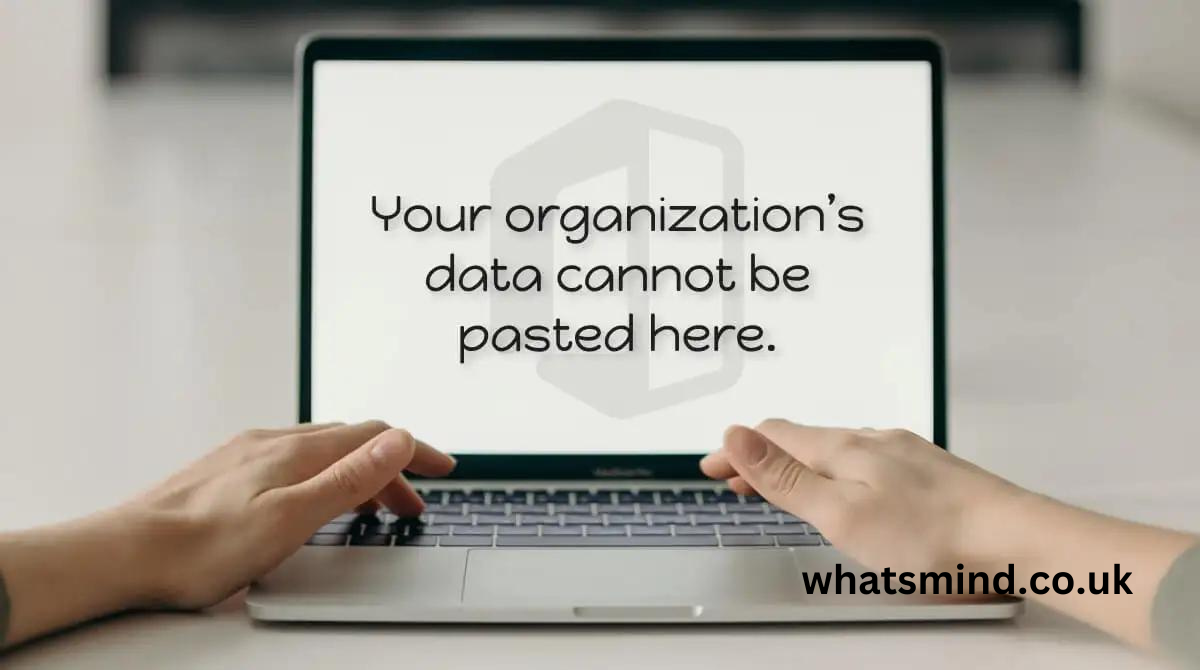Introduction
In today’s digital age, data security has become a paramount concern for organizations across the globe. With the increasing prevalence of cyber threats, companies are implementing stringent data protection policies to safeguard their sensitive information. One common message employees might encounter is “Your organization’s data cannot be pasted here.” This restriction is a crucial part of data security measures designed to prevent unauthorized sharing and potential breaches.
Understanding Data Restrictions
What Does “Your Organization’s Data Cannot Be Pasted Here” Mean?
When you see the message “Your organization’s data cannot be pasted here,” it indicates that the system has detected an attempt to transfer data to an unapproved location. This could be a result of trying to copy and paste sensitive information from a secure environment to a less secure one, such as personal email or an external website.
Common Scenarios Where This Restriction Applies
- Emailing Sensitive Information: Attempting to paste confidential data into an external email service.
- Using Unapproved Applications: Trying to transfer data to software that has not been vetted by the organization’s IT department.
- Sharing via Social Media: Copying and pasting sensitive information into social media platforms or messaging apps.
Reasons Behind Data Restrictions
Protecting Sensitive Information
One of the primary reasons for data restrictions is to protect sensitive information. Organizations deal with a vast amount of confidential data, including financial records, customer information, and proprietary research. Preventing unauthorized access to this data is crucial for maintaining security and trust.
Preventing Data Breaches
Data breaches can have severe consequences, including financial losses, legal ramifications, and damage to an organization’s reputation. By restricting the ability to paste sensitive data into insecure locations, companies can significantly reduce the risk of breaches.
Ensuring Compliance with Regulations
Many industries are subject to strict regulations regarding data protection. Compliance with these regulations, such as GDPR, CCPA, and HIPAA, is essential to avoid hefty fines and legal issues. Data restrictions help ensure that employees adhere to these regulatory requirements.
Types of Data Affected
Sensitive and Confidential Information
Sensitive information includes data that could cause harm if disclosed, such as business plans, trade secrets, and strategic initiatives. Protecting this information is vital for maintaining a competitive edge.
Intellectual Property and Trade Secrets
Intellectual property (IP) and trade secrets represent the lifeblood of many organizations. Unauthorized sharing of IP can lead to significant financial losses and competitive disadvantages.
Personal Identifiable Information (PII)
PII includes any data that can identify an individual, such as names, addresses, social security numbers, and financial information. Protecting PII is not only a legal requirement but also a moral obligation to safeguard individuals’ privacy.
Technological Implementations
Data Loss Prevention (DLP) Tools
DLP tools are designed to monitor and control the transfer of sensitive data. These tools can detect attempts to copy, move, or share restricted information and block such actions if they violate security policies.
Encryption and Access Controls
Encryption ensures that data is unreadable to unauthorized users, adding a layer of security even if the data is intercepted. Access controls limit who can view or manipulate sensitive information, ensuring that only authorized personnel have access.
Monitoring and Auditing Systems
Continuous monitoring and auditing help organizations detect and respond to potential security incidents in real-time. These systems track data movements and user activities, providing insights into possible security breaches.
Impact on Daily Operations
Challenges Faced by Employees
While data restrictions are essential for security, they can sometimes pose challenges for employees. Navigating these restrictions without compromising productivity requires understanding and adherence to organizational policies.
Balancing Security and Productivity
Organizations must find a balance between stringent security measures and maintaining employee productivity. Providing secure, approved tools for data sharing can help achieve this balance.
Best Practices for Employees
Understanding Your Organization’s Data Policies
Employees should familiarize themselves with their organization’s data security policies. Knowing what is permissible and what isn’t can prevent accidental breaches and ensure compliance.
Secure Ways to Share Information
When sharing sensitive information, use approved platforms and tools provided by the organization. These tools are designed to protect data and comply with security policies.
Using Approved Platforms and Tools
Always use IT-approved software for work-related tasks. Avoid using personal email accounts, social media, or unauthorized applications for transferring sensitive data.
Training and Awareness
Importance of Regular Training Programs
Regular training programs are crucial for keeping employees informed about data security policies and best practices. Continuous education helps reinforce the importance of data protection and reduces the risk of breaches.
Creating a Culture of Security Awareness
Fostering a culture of security awareness involves encouraging employees to prioritize data protection in their daily activities. This includes reporting suspicious activities and adhering to security protocols.
Handling Data Restrictions
Steps to Take When Encountering Data Restrictions
If you encounter a data restriction message, follow these steps:
- Review the Policy: Understand why the restriction is in place.
- Use Approved Methods: Find alternative ways to share information that comply with security policies.
- Seek Assistance: Contact your IT or security department for guidance if you’re unsure how to proceed.
Who to Contact for Assistance
When in doubt, reach out to your organization’s IT or security team. They can provide support and help you navigate data restrictions effectively.
Case Studies
Real-Life Examples of Data Breaches
Examining real-life examples of data breaches can highlight the importance of data security policies. For instance, breaches at major companies have led to significant financial and reputational damage.
Lessons Learned and Best Practices
These case studies often reveal best practices for preventing breaches, such as regular audits, employee training, and robust security measures.
Benefits of Data Security Policies
Protecting the Organization’s Reputation
Strong data security policies help protect an organization’s reputation by preventing breaches that could damage trust and credibility.
Safeguarding Customer Trust
Customers entrust organizations with their personal information. Protecting this data is crucial for maintaining customer trust and loyalty.
Legal and Financial Advantages
Compliance with data protection regulations can prevent costly fines and legal issues. Moreover, robust security measures can save organizations from the financial fallout of a data breach.
Future Trends in Data Security
Emerging Technologies and Solutions
The field of data security is continually evolving. Emerging technologies, such as AI and machine learning, are enhancing the ability to detect and prevent breaches.
Adapting to Evolving Threats
As cyber threats become more sophisticated, organizations must adapt their security measures to stay ahead of potential risks. Continuous improvement and innovation are key to maintaining data security.
Regulatory Compliance
Overview of Key Regulations (GDPR, CCPA, HIPAA)
Understanding key data protection regulations, such as GDPR, CCPA, and HIPAA, is essential for ensuring compliance. These regulations set the standards for handling and protecting personal information.
How Organizations Ensure Compliance
Organizations ensure compliance through regular audits, employee training, and implementing robust security measures that align with regulatory requirements.
Personal Stories
Employees Sharing Their Experiences
Hearing from employees who have successfully navigated data restrictions can provide valuable insights and practical tips.
How They Adapt to Data Restrictions
These personal stories can highlight effective strategies for adapting to data restrictions while maintaining productivity and security.
Conclusion
Data security policies, such as restricting the ability to paste sensitive information, are vital for protecting an organization’s most valuable assets. Understanding the reasons behind these policies, the types of data affected, and how to navigate restrictions can help employees maintain security without compromising productivity. By fostering a culture of security awareness and providing regular training, organizations can safeguard their data and stay ahead of evolving threats.
FAQs
What should I do if I encounter a data restriction message?
If you encounter a data restriction message, review your organization’s data security policy, use approved methods for sharing information, and seek assistance from your IT or security team if needed.
Why is it important to adhere to data security policies?
Adhering to data security policies is crucial for protecting sensitive information, preventing data breaches, and ensuring compliance with regulations. It helps safeguard the organization’s reputation and maintains customer trust.
How can I securely share sensitive information within my organization?
To securely share sensitive information, use approved platforms and tools provided by your organization. Avoid using personal email accounts, social media, or unauthorized applications.
What are the consequences of not following data security guidelines?
Failing to follow data security guidelines can lead to data breaches, financial losses, legal ramifications, and damage to the organization’s reputation. It can also result in regulatory fines and loss of customer trust.
How can I stay updated on my organization’s data security policies?
Stay updated on your organization’s data security policies by participating in regular training programs, reading policy updates from the IT or security department, and staying informed about emerging security threats and best practices.


